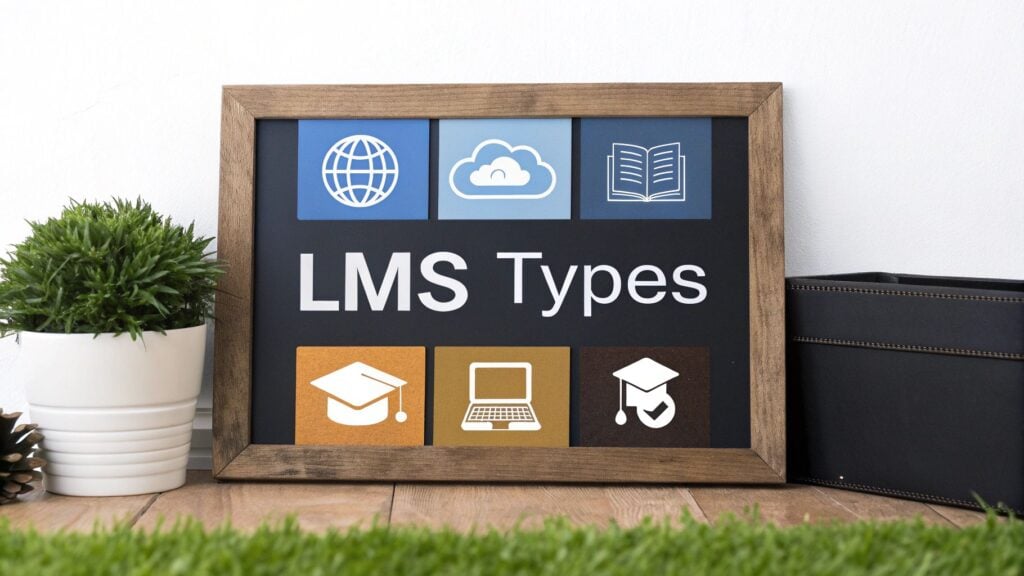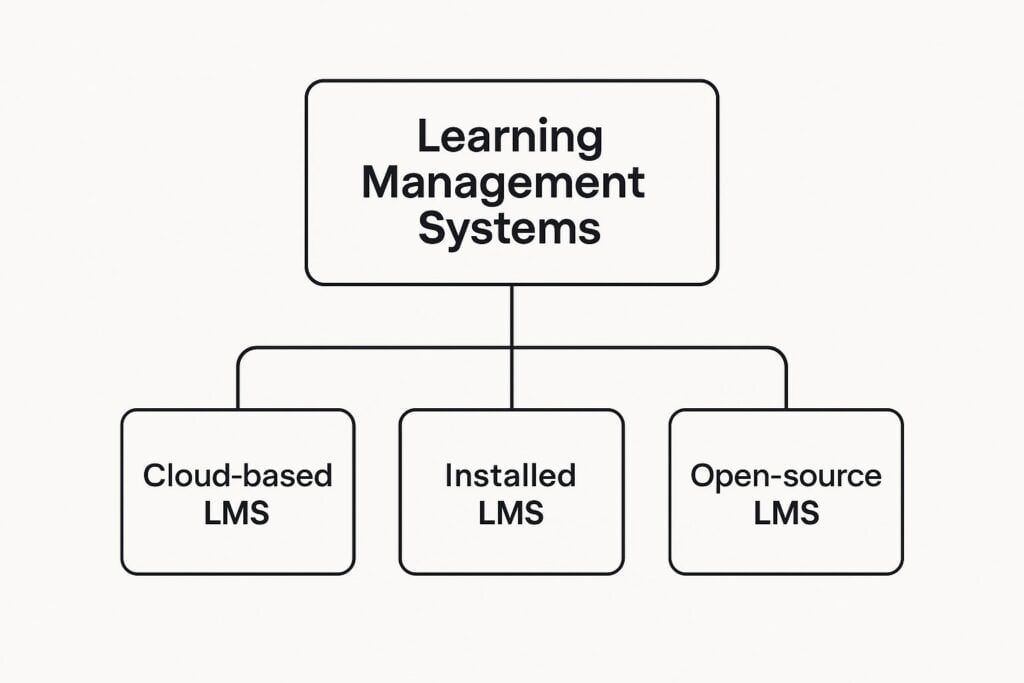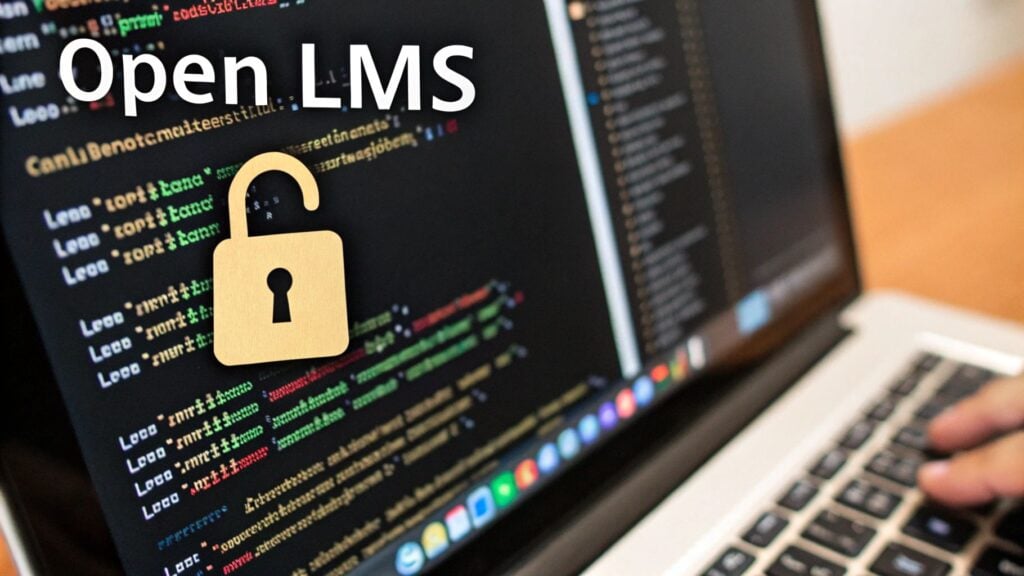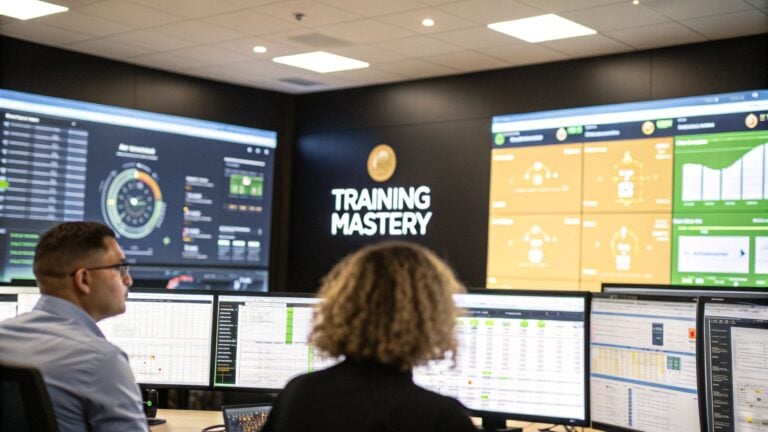A Guide to Learning Management Systems Types

Diving into the world of learning management systems (LMS) can feel a bit like learning a new language. At its heart, an LMS is the digital home for all your courses and training programs. It’s the command center you use to create, deliver, and track learning content.
The main learning management systems types usually fall into categories based on how they’re hosted, how they’re built, and who they’re built for. Getting a handle on these differences is the first step to finding the right fit.
What Are the Main Types of Learning Management Systems?
I like to think of an LMS as the central nervous system for your entire educational operation, whether you’re training a global team or running a university department. It’s the software that wrangles all your learning materials into one cohesive experience.
The demand for these platforms has exploded. The market has ballooned from $8.76 billion in 2019 to an estimated $22.1 billion in 2023. That’s not just growth. It’s a fundamental shift in how organizations approach learning and development.
The image below gives you a quick visual breakdown of the main categories you’ll run into.

As you can see, your first big decision boils down to a few core paths. Do you want a system managed for you (cloud-based), one you control completely on your own servers (installed), or a flexible, community-driven option (open-source)?
To help you get your bearings right away, the table below offers a quick snapshot of the main LMS categories we’ll be exploring. It’s a simple guide to help you start connecting the dots.
Quick Guide to LMS Types at a Glance
| LMS Category | Key Characteristic | Best For |
|---|---|---|
| Cloud-Based (SaaS) | Hosted by the vendor, you pay a subscription fee. | Organizations that want a hands-off, low-maintenance solution. |
| Self-Hosted (Installed) | You buy the license and install it on your own servers. | Companies with dedicated IT teams that need full control and security. |
| Open-Source | The source code is free and can be customized. | Tech-savvy organizations that want maximum flexibility and no license fees. |
| Proprietary (Commercial) | Owned and developed by a single company, requires a license. | Businesses looking for dedicated support and a polished, ready-to-go product. |
| Corporate | Designed specifically for employee training and development. | Companies focused on onboarding, compliance, and upskilling their workforce. |
| Academic | Built for schools, colleges, and universities. | Educational institutions that need tools for grading, student management, and classroom collaboration. |
In this guide, we’ll break down the key decisions you’ll face:
- Hosting: Will it be managed for you in the cloud, or will you host it on your own servers?
- Architecture: Is it built with flexible open-source code, or is it a polished, proprietary system?
- Audience: Is it designed for corporate training or for academic institutions?
Understanding these core distinctions is the first step toward finding a system that truly fits your goals. Every organization has different needs, so there’s no single “best” type, only the one that works for you.
To see how these concepts look in the real world, check out our guide on learning management system examples. And for a broader look at the digital tools changing how we teach and learn, it’s worth exploring the wide range of educational technology tools, including LMS platforms.
By the end of this guide, you’ll have a clear map to navigate all your options. Let’s get started.
Cloud Based vs Self Hosted LMS Platforms
When you’re picking an LMS, one of the first forks in the road is deciding where it will “live.” This choice between different learning management systems types boils down to a simple question: Do you want to rent a fully-furnished apartment, or build your own house from the ground up?
Each path comes with its own set of perks and headaches. The right one for you really depends on your budget, your team’s technical skills, and just how much control you truly need over your learning environment.

The Convenience of a Cloud-Based LMS
A cloud-based LMS, often called a SaaS (Software as a Service) platform, is exactly like renting that apartment. The provider owns the building (the servers), takes care of all the maintenance, fixes any leaks (bugs), and handles security. You just pay a subscription fee, move your stuff in, and start decorating.
There’s a reason this is the most popular route. It’s fast, convenient, and the costs are predictable. You don’t need an IT army on standby just to keep the lights on.
Here’s where it really shines:
- Quick and Easy Setup: Forget waiting for months. You can get a cloud-based LMS up and running in a matter of hours or days.
- Lower Upfront Costs: Instead of a massive one-time investment, you pay a predictable monthly or annual subscription fee. This makes budgeting a whole lot easier.
- Automatic Updates and Maintenance: The vendor handles all the tedious stuff like software updates, security patches, and server maintenance behind the scenes.
- Scalability on Demand: Need to add more users next month? Just upgrade your plan. The system grows with you without you ever needing to think about buying more hardware.
Of course, just like renting an apartment, you don’t own the place. The biggest trade-off is control. You might find customization options are limited, and you’re ultimately relying on your provider’s security measures and uptime.
The Power of a Self-Hosted LMS
Now, let’s talk about building your own house. A self-hosted LMS, sometimes called an on-premise solution, is a piece of software you buy or download and then install on your own servers. You own it, you control it, and you’re responsible for everything from the foundation to the roof.
This approach gives you the ultimate freedom. If you want to knock down a wall, add a new room, or paint everything bright orange, you can. It’s the perfect fit for large organizations with very specific, non-negotiable requirements, strict data security policies, or a deep need to integrate the LMS with other internal systems.
A self-hosted LMS offers maximum control, which is essential for organizations with unique security or customization needs. You are in the driver’s seat for every single aspect of the platform.
Here’s what you gain by taking the reins:
- Complete Customization: You can modify the code, overhaul the design, and build custom features that perfectly match your workflow.
- Total Data Control: Your data never leaves your servers. For industries like healthcare or finance, this is often a critical compliance requirement.
- One-Time Licensing Fee: In many cases, you pay a one-time license fee. Over the long haul, this can be far more cost-effective than paying a subscription fee year after year.
But with great power comes great responsibility. You’ll need a dedicated IT team ready to handle the initial installation, ongoing updates, security monitoring, and any troubleshooting that comes up. The initial cost for servers and software can also be pretty steep. It’s an incredibly powerful option, but it demands a serious investment in both time and money.
Beyond where your LMS lives online, you have another big decision to make: how it’s built. This is where the debate between open source and proprietary systems comes in, and it’s a fundamental choice that shapes everything that follows.
Think of it like deciding between a fully custom-built home and a beautiful home in a planned community. One gives you total control down to the studs, while the other offers a polished, move-in-ready experience. Neither is inherently better, but your choice will impact your budget, customization options, and the kind of support you can expect down the line.

The Freedom of Open Source LMS
An open source LMS is that custom-built home. The architectural plans, the source code, are publicly available, often for free. You can take those plans and build whatever you want, adding rooms, moving walls, and choosing every single finish to match your exact vision.
Platforms like Moodle are the poster child for this approach. You can download the core software without paying a dime, which is a massive draw for universities, non-profits, or any organization watching its budget closely.
But “free” doesn’t mean no cost. Just like with a custom home, the free plans are only the beginning. You still have to pay for the land, the materials, and the construction crew. In the LMS world, this translates to real costs for:
- Hosting and Servers: You need a place for your LMS to live online.
- Technical Expertise: You need a skilled developer or an IT team to install, configure, customize, and maintain the system. This is non-negotiable.
- Ongoing Support: When something breaks or a security vulnerability pops up, you’re the one responsible. You’ll rely on community forums or pay for third-party support contracts.
This path offers incredible flexibility and control, but only if you have the technical horsepower to manage it effectively.
An open source LMS gives you complete freedom to build and modify, but it requires you to handle all the setup, maintenance, and security yourself. It’s a powerful option for those with strong in-house IT skills.
The Polish of a Proprietary LMS
A proprietary LMS, on the other hand, is like buying that home in a professionally managed community. A dedicated company has already designed the layout, handled the construction, and landscaped the yard. You pay a fee for a polished, reliable product that just works.
These systems are built to be user-friendly right out of the box. You get a dedicated support team to call for help, predictable feature updates, and a slick user experience that has been tested and refined based on feedback from thousands of other customers.
This model is a perfect fit for organizations that want to focus on creating amazing learning experiences, not on managing software infrastructure. Yes, you pay a licensing or subscription fee, but you’re buying peace of mind, predictability, and a partner dedicated to the platform’s success.
The trend in education, particularly higher education, shows a strong preference for this model’s reliability. For instance, Instructure’s Canvas LMS now holds a market share larger than its next three competitors combined, while older open-source options have seen their usage decline. You can explore the most current numbers in the latest LMS market share data from EduTechnica.
Ultimately, the choice comes down to a simple question: Do you want to build it yourself, or do you want to buy it ready-made?
2. How Businesses Use a Corporate LMS
Alright, let’s shift gears from the academic world and talk about how businesses put learning management systems to work. A corporate LMS is a strategic tool, built from the ground up to sharpen employee skills and, ultimately, grow the bottom line. Its core job is to help companies train their people, whether that’s new hires, seasoned veterans, channel partners, or even customers.
Think about the last time you started a new job. Remember the mountain of paperwork and the disjointed orientation sessions? A corporate LMS smooths out that entire process. It can also deploy mandatory compliance training across thousands of employees with just a few clicks or get your entire sales team up to speed on a new product before it even launches. That’s the kind of practical power we’re talking about.

These systems are laser-focused on efficiency, tracking, and showing a clear return on investment (ROI). You won’t find features for managing semester grades here. Instead, you’ll see tools designed for the workplace, like managing professional certifications, tying training to performance reviews, and plugging directly into other business software like your HR platform or CRM.
Driving Real Business Results
The corporate LMS market is booming, and for a good reason. Companies are finally realizing that investing in their team’s skills is a direct investment in their own success. This isn’t just a gut feeling. The numbers tell a compelling story.
The market was valued at a hefty USD 12.02 billion in 2024 and is projected to skyrocket to around USD 72.30 billion by 2034. That explosive growth is all about the increasing need for effective employee training and skill development programs across the globe. You can dig deeper into the corporate LMS market growth at Precedence Research.
So, what does this look like day-to-day? Here are a few ways companies use these platforms to build a smarter, more productive workforce.
- Employee Onboarding: A good LMS automates the entire onboarding journey. It delivers consistent training on company culture, essential policies, and job-specific skills to every single new hire, ensuring nobody misses a beat.
- Compliance Training: In industries with strict regulations (think healthcare or finance), an LMS is a lifesaver. It makes it simple to assign, track, and generate reports on mandatory training for things like safety protocols or data privacy.
- Sales Enablement: Sales teams can get up to speed fast on new products, sharpen their sales techniques, and study competitor intel. This keeps them ready to hit their targets and close deals.
- Customer Education: Forward-thinking companies use an LMS to teach customers how to get the most out of their products. This cuts down on support tickets and builds a loyal, happy customer base.
A corporate LMS isn’t just a nice-to-have anymore. It’s a core part of a company’s strategy for staying competitive. It helps build a smarter, more capable team that can adapt to whatever comes next.
The Focus on Skills and Performance
Unlike its academic cousin, the goal here is tied directly to job performance. It’s all about closing skill gaps, boosting productivity, and ensuring everyone has the knowledge they need to crush it in their role. The features inside these platforms reflect this business-first mindset.
Many corporate platforms double as a powerful course management system, letting managers design custom learning paths for their teams. If you want to explore the nuances, you can learn more about how a course management system works in our detailed guide. At the end of the day, these systems are the engines that power a culture of continuous learning and development within an organization.
On the other side of the aisle from corporate training tools, you have the academic LMS. These are the digital engines humming away in schools, colleges, and universities everywhere. Their entire job is to support the educational journey, from a first-grader learning to read all the way to a PhD candidate finishing their dissertation.
I always think of an academic LMS as a virtual classroom that never closes its doors. It’s the central hub where professors post syllabi, students frantically submit assignments at 11:59 PM, and classmates hash out ideas in online discussion forums. These platforms are the true backbone of modern education, especially as blended learning has become the standard.
Built for the Rhythms of Education
Unlike their corporate cousins, academic learning management systems are designed around the natural cycles of education. They get terms like semesters, gradebooks, and the registrar’s office. Their whole feature set is geared toward creating a structured, collaborative learning environment that serves both instructors and students.
Platforms like Canvas and Blackboard have become completely central to the student experience. They’re not just supplemental tools anymore. For many, they are the primary place where learning happens outside of the physical lecture hall. Academic LMS platforms are a cornerstone of modern learning, driving major shifts in how institutions operate. You can learn more about mastering digital transformation in education and the important role this technology plays.
Here are a few of the core features that make these systems so indispensable for schools:
- Gradebooks and Assessment Tools: This is a huge one. Teachers can manage assignments, track grades, and give feedback all in one spot, saving an incredible amount of administrative time.
- Course Calendars and Syllabi: Everything a student needs to know about a course, from deadlines to reading materials, is organized and accessible 24/7.
- Discussion Forums: These basically function as virtual study groups. They give students a space to ask questions, share insights, and connect with the material outside of scheduled class time.
- Integration with Student Information Systems (SIS): This is the behind-the-scenes magic. Academic platforms talk directly to a school’s core database to manage class rosters and keep official records in sync.
The real magic of an academic LMS is how it extends the classroom. It creates a persistent learning space where education continues long after the bell rings.
Fostering Collaboration and Community
A huge focus for these platforms is building a sense of community among students. They include tools designed to get students working together and learning from each other, whether it’s through group projects, peer review assignments, or shared collaborative documents.
By pulling all these activities into one place, an academic LMS helps create a cohesive and supportive learning experience. It’s the digital thread that ties students, instructors, and the curriculum together into a single, organized whole.
How to Choose the Right LMS for Your Needs

We’ve covered a lot of ground on the different types of learning management systems. Now for the most important part: figuring out which one is the perfect match for you.
The right answer depends entirely on your specific goals. Are you a startup looking for a simple way to onboard new team members? Or are you a large university managing courses for thousands of students? The needs are worlds apart, and so are the solutions.
First Things First: Define Your Core Goals
Before you even think about watching a demo, you have to get crystal clear on what you actually want the system to do. What’s the core problem you’re trying to solve?
Getting this “why” nailed down makes every other decision a whole lot easier. Are you focused on employee development, academic course delivery, or maybe selling courses online? Each of these goals points toward a completely different kind of platform.
Your core objective is the single most important filter. A system built for corporate compliance training will be a frustrating choice for a creative arts school, and vice versa.
Once you know your main objective, you can start digging into the details that matter.
A Practical Checklist to Narrow Your Options
Alright, let’s get practical. I’ve found that asking a few key questions can quickly shrink your list of options from hundreds down to just a handful of real contenders.
Here’s a checklist to guide your thinking:
- Who are your learners? Are they tech-savvy employees who can handle a complex interface, or students who need something super intuitive? The user experience absolutely must fit the audience.
- What’s your real budget? Be honest about upfront costs (like you might have with a self-hosted system) versus ongoing subscription fees (the norm for cloud-based platforms). Don’t forget to factor in potential costs for support, customization, or extra features down the road.
- What technical resources do you have? Do you have a dedicated IT team ready to manage an open-source platform, or do you need a hands-off SaaS solution that just works?
- What features are non-negotiable? Make a list of your absolute must-haves. This could be anything from great mobile access and specific integrations to robust reporting and analytics. When choosing, think about whether it can integrate with or even replace tools like dedicated knowledge base software to centralize your information.
Thinking through these points creates a clear framework for your decision. It ensures you’re choosing a system based on what you actually need, not just flashy features that look good in a sales pitch.
And remember, a well-designed course is just as crucial as the platform it lives on. This is a great time to review some instructional design best practices to make sure your content truly shines, no matter which LMS you pick.
Which LMS Type Is Right for You?
To make it even simpler, this table breaks down which LMS category best aligns with common business priorities. Think of it as a quick-start guide to point you in the right direction.
| If Your Priority Is… | Consider This LMS Type | Why It Fits |
|---|---|---|
| Complete Control & Customization | Open-Source | You get full access to the source code to build a completely unique platform. |
| Fast Setup & Low Maintenance | Cloud-Based (SaaS) | The provider handles all the technical stuff, so you can focus on your content. |
| Strict Data Security & Privacy | Self-Hosted | All data lives on your own servers, giving you maximum control over security. |
| Selling Courses to the Public | Commercial | These are built with e-commerce, marketing, and sales tools right out of the box. |
| Free, Community-Driven Solution | Open-Source | The software is free, and a large user community provides support and plugins. |
| Predictable Monthly Costs | Cloud-Based (SaaS) | Subscription models make budgeting straightforward with no surprise expenses. |
| Integrating with Existing Systems | All types, but check APIs | Most modern systems integrate well, but SaaS and Commercial often have more pre-built connections. |
| Scalability for a Growing Audience | Cloud-Based (SaaS) | Easily scale your user count up or down without worrying about server capacity. |
Ultimately, the goal is to find a system that feels like a natural extension of your organization. By starting with your goals and using this checklist, you’ll be well on your way to finding an LMS that doesn’t just work, but helps you achieve exactly what you set out to do.
Have Questions? Let’s Clear Things Up.
As you explore all the different flavors of learning management systems, a few questions always seem to pop up. Let’s tackle some of the most common ones I hear from folks trying to find the right fit.
Can I Switch From One LMS Type to Another Later On?
The short answer is yes, but the longer, more honest answer is that it’s a real headache. Moving all your data, every course, every user progress report, every single file, from one system to another requires a ton of careful planning.
Think of it like moving from an apartment you rent to a house you own. Switching between two cloud-based systems is like moving to a different apartment in the same building. It’s manageable, but still work. But migrating from a self-hosted platform to a cloud one? That’s the full-blown cross-country move with a moving truck, boxes, and a lot of potential for things to get lost.
To save yourself a massive headache down the road, it’s always better to pick a system that you can grow into, not one you’ll quickly grow out of.
Is an Open-Source LMS Really Free?
While the software itself is free to download, running an open-source LMS is definitely not free of cost. You’ll still need to pay for things like web hosting, server maintenance, and keeping everything secure.
Remember, “free software” does not mean “free of cost.” Always budget for the operational expenses needed to run it effectively, especially if you don’t have an in-house IT team to handle the technical side.
On top of the basics, you’ll likely need to budget for developers if you want to add custom features or make specific tweaks. So while you dodge the subscription fee, a whole different set of expenses pops up.
What’s the Best LMS for Selling Online Courses?
This one really comes down to what you’re trying to accomplish.
If your main goal is selling courses directly to individual customers, you’ll want a corporate LMS that’s built with strong e-commerce features. These platforms usually come ready with built-in payment gateways, marketing tools, and everything you need to run a storefront.
On the other hand, an academic LMS is almost never the right choice for this. They’re designed for classrooms and student grades, not for processing credit cards and running sales promotions. You should also look into specialized course creation platforms, as many are designed from the ground up specifically for entrepreneurs and creators.






